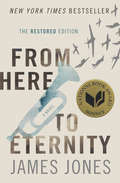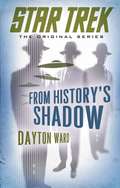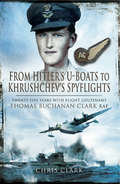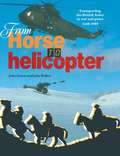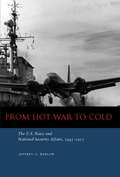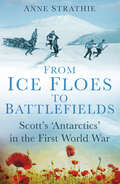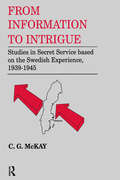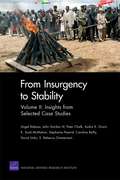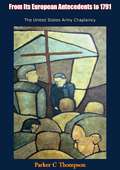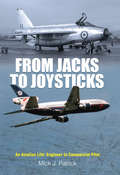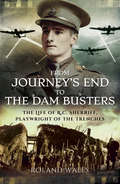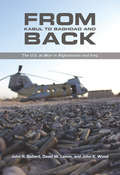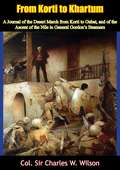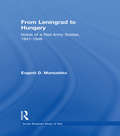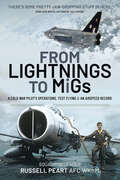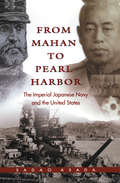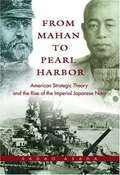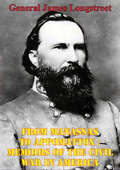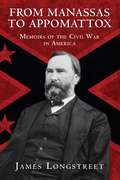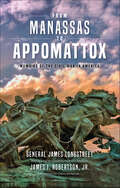- Table View
- List View
From Here to Eternity: The Restored Edition (The World War II Trilogy #1)
by James JonesA novel of army life in the calm before Pearl Harbor: A New York Times bestseller, a National Book Award winner, and &“one of the great books of our time&” (Newsday). At the Pearl Harbor army base in 1941, Robert E. Lee Prewitt is Uncle Sam&’s finest bugler. A career soldier with no patience for army politics, Prewitt becomes incensed when a commander&’s favorite wins the title of First Bugler. His indignation results in a transfer to an infantry unit whose commander is less interested in preparing for war than he is in boxing. But when Prewitt refuses to join the company team, the commander and his sergeant decide to make the bugler&’s life hell. An American classic now available with scenes and dialogue considered unfit for publication in the 1950s, From Here to Eternity is a stirring picture of army life in the months leading up to the attack on Pearl Harbor. This ebook features an illustrated biography of James Jones including rare photos from the author&’s estate.
From Here to You (Crash and Burn #1)
by Jamie McGuireDiscover a new series from the author of the #1 New York Times bestseller Beautiful Disaster: a "heartbreaking and hopeful, raw and sexy" tale about a woman on the run who encounters a stranger with a secret (Lauren Blakely, author of Part-Time Lover). As Darby Dixon sits in a tiny Texas church bathroom on her wedding day holding a positive pregnancy test, she realizes that marrying her fiancé would be the worst decision of her life. She's never been very good at standing up for herself, but she'll sure as hell stand up for her baby. With very little cash and a ton of courage, she flees town to take a new name and start a new life.As a Marine, Scott "Trex" Trexler worked in the most treacherous, corrupt, war-torn places on earth. With his new top-secret security job, he finally has a chance to return to the one place he's felt at peace: Colorado Springs, Colorado.The moment Trex checks in at the hotel where she's working, Darby knows he's dangerous. He may want her to think he's another hotshot firefighter, along with all the others battling the nearby mountain blaze, but something doesn't add up. No way will she get involved with another man she can't fully trust - and Trex clearly isn't telling her everything. As Darby's ex gets closer and closer to finding her, both she and Trex will soon find out that what you don't know can hurt you."Jamie McGuire writes with no holds barred ... real and addictive." -USA Today"Jamie McGuire is masterful at emotional romance!" -Lauren Blakely, #1 New York Times bestselling author
From History's Shadow (Star Trek: The Original Series)
by Dayton WardAn original novel set in the universe of Star Trek: The Original Series!2268: Following the encounter with the mysterious Gary Seven in the twentieth century, the crew of the U.S.S. Enterprise is startled by two intruders who have transported through space and time from Earth circa 1968. Incredibly, one of the infiltrators is a Vulcan, who asserts that he&’s lived among Earth&’s population for over a decade. The other represents a little-known race, and reveals to Captain James T. Kirk that she has spent the last twenty years working to bring about humanity&’s destruction. It is then that Gary Seven&’s young protégée, Roberta Lincoln, arrives seeking Kirk&’s help... 1947: In the wake of the infamous &“Roswell Incident&” involving a crashed alien craft and beings from another world, Captain James Wainwright finds himself recruited as one of the first members of Majestic 12, a secret organization with two goals: Collect evidence of extraterrestrial activity on Earth, and develop strategies to combat alien invaders. And it is this very mission that will consume Wainwright&’s life for the next two decades, driven by the knowledge that the danger is as real as the aliens living among us...
From Hitler's U-Boats to Khruschev's Spyflights: Twenty Five Years with Flight Lieutenant Thomas Buchanan Clark, RAF
by Chris ClarkeThis book tells the tale of the illustrious Royal Air Force career of Tom Clark, a World War Two gunner and post-war signaller in action during some of the most pivotal events of the twentieth century. Lovingly penned by his son, it provides an authentic insight into this dynamic period of world history.From work as an air gunner, involved in the daunting task of taking on the might of Hitler's U-boat fleet, to post-war involvement in an Intelligence capacity during the dramatic events surrounding Khrushchev and the atomic threat of the late 1950s, Clark's career was dramatic and varied to say the least. Having joined the RAF as an aircraft man just before the Second World War, Clark was destined to take part in a whole range of wartime operational engagements. His career featured involvement in the famous 1941 hunt for the elusive Bismarck, the dangers of life as part of an Air Sea Rescue squadron in conflicted waters, and the experience of training as a gunnery leader (later an instructor), training air gunners for the famed Desert Air Force. His career also took in a fraught period behind enemy lines, when his crew of four were shot down in enemy territory in Northern Italy. Seven weeks in a safe house in Florence are relayed in engaging and dramatic style, as are a raft of other personal and professional achievements, set within the context of the wider conflict. Here is a career that deserves to be recorded and celebrated, and there is perhaps no-one better placed than the subject's son to act as custodian to his thrilling story.
From Horse to Helicopter: Transporting the British Army in War and Peace 1648–1989
by John Walker John SuttonThis is a pictorial history of Army transportation. The book outlines the development of the three modes of transport used in supporting the British Army on land, in water and in air, from the horse to the helicopter. Both the authors are retired officers who served in the Royal Corps of Transport.
From Hot War to Cold
by Jeffrey G. BarlowThis book discusses the role of the U. S. Navy within the country's national security structure during the first decade of the Cold War from the perspective of the service's senior uniformed officer, the Chief of Naval Operations, and his staff. It examines a variety of important issues of the period, including the Army-Navy fight over unification that led to the creation of the National Security Act of 1947, the early postwar fighting in China between the Nationalists and the Communists, the formation of NATO, the outbreak of the Korean War, the decision of the Eisenhower Administration not to intervene in the Viet Minh troops' siege of the French garrison at Dien Bien Phu, and the initiation of the Eisenhower "New Look" defense policy. The author relies upon information obtained from a wide range of primary sources and personal interviews with important, senior Navy and Army officers. The result is a book that provides the reader with a new way of looking at these pivotal events.
From Hunter to Hunted: The U-Boat War in the Atlantic, 1939–1943
by Bernard EdwardsThe author of Churchill’s Thin Grey Line shares case histories from World War II’s Battle of the Atlantic featuring the German U-boat.In the early stages of World War II, Donitz’s U-boats generally adhered to Prize rules, surfacing before attacking and making every effort to preserve the lives of their victims’ crews. But, with the arming of merchantmen and greater risk of damage or worse, they increasingly attacked without warning.So successful was the U-boat campaign that Churchill saw it as the gravest threat the nation faced. The low point was the March 1943 attack on convoys SC122 and HX229 when 44 U-boats sank 22 loaded ships.The pendulum miraculously swung with improved tactics and technology. In May, 1943, out of a force of over 50 U-boats that challenged ONS5, eight were sunk and 18 were damaged, some seriously. Such losses were unsustainable, and, with allied yards turning out ships at ever increasing rates, Donitz withdrew his wolf packs from the North Atlantic.Expert naval author and historian Bernard Edwards traces the course of the battle of the Atlantic through a series of thrilling engagement case studies.Praise for From Hunter to Hunted “Expertly written, it portrayed the perils and dramas of warfare in the North Atlantic between the convoys and German U boats . . . Reading [Edwards’s] accounts made me feel as though I was present. A cracking and informative read— I will definitely read more by Captain Edwards and I highly commend it.” —Adrian Greaves, author of The Zulus at War
From Ice Floes to Battlefields: Scott’s ‘Antarctics’ in the First World War
by Anne StrathieFebruary 1912: Harry Pennell and his Terra Nova shipmates brave storms and ice to bring supplies to Antarctica. They hope to celebrate Captain Scott’s conquest of the South Pole, but are forced by ice to return north before Scott’s party returns. In New Zealand a reporter tells them that Roald Amundsen reached the Pole first. Returning to Antarctica in early 1913, they learn that Scott’s party reached the Pole but died on the ice shelf. Back in Britain memorial services, medal ceremonies, weddings and resumed careers are abruptly interrupted by the First World War. Fit and able men, Scott’s ‘Antarctics’ trade one adventure for another. By 1919 Scott’s ‘Antarctics’ have fought at Antwerp, the Western Front, Gallipoli, in the Channel, at Jutland and in Arctic Russia. They serve on horseback, in trenches, on battleships and hospital ships, in armoured cars and flimsy aircraft; their brothers-in-arms include a prime minister’s son and poet Rupert Brooke. As in Antarctica, life is challenging and dangerous. As on the ice, not all survive.
From Immigrant to Inventor: and Pioneer of Electrical Transmission and the Long-Distance Telephone Line
by Michael Idvorsky PupinFrom Immigrant to Inventor is the inspiring autobiography of Michael Idvorsky Pupin, chronicling his extraordinary journey from a modest childhood in rural Serbia to becoming a distinguished scientist, inventor, and professor in the United States. Originally published in 1923, the book offers a personal and reflective narrative of perseverance, intellectual discovery, and the immigrant experience during a transformative era in American history.Pupin begins with memories of his upbringing in a Serbian village, where curiosity about the natural world first sparked his lifelong passion for learning. He then recounts his emigration to the United States as a young man, arriving with little more than determination and dreams of an education. The narrative unfolds with his struggles to adapt to a new culture, working tirelessly to fund his studies and overcome the challenges of poverty.Central to the story is Pupin’s education at Columbia University and further scientific training in Europe, where he immersed himself in physics, mathematics, and engineering. The book traces his groundbreaking inventions in telecommunication and electrical transmission—work that played a pivotal role in advancing wireless communication and earning him numerous patents and accolades, including the Pulitzer Prize for this very memoir.Beyond recounting his personal achievements, Pupin reflects on the broader themes of science, innovation, and the opportunities available to immigrants in America. He emphasizes the importance of education, hard work, and resilience, inspiring readers with his belief that adversity can be a catalyst for greatness.A blend of memoir, science, and philosophy, From Immigrant to Inventor offers a timeless exploration of the immigrant spirit and the transformative power of knowledge. It is a compelling read for those interested in the history of technology, the immigrant experience, and the life of one of the most influential inventors of the 20th century.
From Imperial Splendour to Internment: The German Navy in the First World War
by Nicolas WolzThis important new work describes how the Imperial German Navy, which had expanded to become one of the great maritime forces in the world, second only to the Royal Navy, proved, with the exception of its submarines, to be largely ineffective throughout the years of conflict.The impact of this impotence had a far-reaching effect upon the service. Germany, indeed most of Europe, was in the grips of a spirit of militant nationalistic fervour, and the inactivity of the great Imperial Navy caused deep frustration, particularly among the naval officers. Not only were they unable to see themselves as heroes, they were also ridiculed on the home front and felt profoundly humiliated. With the exception of the one sea battle at Jutland, their ships saw little or no action at sea and morale slowly collapsed to a point where, at the end of the war, the crews were in a state of mutiny. The seemingly ludicrous order that forced the fleet to go to sea against the British in 1918 was driven by a sense of humiliation, but coming at the war's end it triggered a revolution because the German sailors wanted no part in such madness. The internment at Scapa Flow was the ultimate shaming. This is a fascinating and perceptive analysis of a whole era, and it contributes substantially to our understanding of the war and its consequences consequences, sadly, that helped pave the way for the Third Reich.
From Information to Intrigue: Studies in Secret Service Based on the Swedish Experience, 1939-1945 (Studies In Intelligence Ser.)
by C.G. McKayThis volume offers an account of some key activities of the Allied secret services and their German counterparts in Sweden during World War II. It also describes in some detail Swedish wartime legislation and Swedish organizations concerned with internal security and intelligence.
From Insurgency to Stability: Insights from Selected Case Studies
by Peter Chalk Angel Rabasa John Gordon Audra K. Grant K. Scott McmahonThis book examines six case studies of insurgencies from around the world to determine the key factors necessary for a successful transition from counterinsurgency to a more stable situation. The authors review the causes of each insurgency and the key players involved, and examine what the government did right--or wrong--to bring the insurgency to an end and to transition to greater stability.
From Insurgency to Stability: Key Capabilities and Practices
by Peter Chalk Angel Rabasa Christopher S. Chivvis John Gordon Audra K. GrantThis book identifies the procedures and capabilities that the U.S. Department of Defense, other agencies of the U.S. government, U.S. allies and partners, and international organizations require in order to support the transition from counterinsurgency, when the military takes primary responsibility for security and economic operations, to stability and reconstruction, when police and civilian government agencies take the lead.
From Its European Antecedents to 1791 The United States Army Chaplaincy
by Parker C ThompsonThis volume is one of a series of five prepared by various authors, designed to be useful and instructive regarding the long history of the United States Army Chaplaincy. The emphasis throughout is on how chaplains did their ministry in the contexts of both war and peace. The series seeks to present as full and as balanced an account as limitations of space and research time permit. The bibliography in each volume offers opportunities for further research. The author of this volume is Chaplain Parker C. Thompson, a Regular Army chaplain of the Southern Baptist Convention. He is a native of Missouri, and entered on active duty as a chaplain in 1952. He has served at Camp Atterbury, Indiana; Fort Leonard Wood, Missouri; Fort Knox, Kentucky; US Army Chaplain Center and School, Fort Hamilton, New York; Fort Dix, New Jersey; and overseas in Korea, Germany, and Vietnam. He has been awarded the Legion of Merit, the Bronze Star Medal (Valor) with 2 Oak Leaf Clusters, the Meritorious Service Medal, the Air Medal, the Army Commendation Medal with 1 Oak Leaf Cluster, and the Purple Heart with 1 Oak Leaf Cluster.
From Jacks to Joysticks: An Aviation Life: Engineer to Commercial Pilot
by Michael John PatrickTrenchard Brat. Flying Spanner. Left Hand Seat. Nicknames abound in aviation. But not many get to be called them all, especially when theyve started life with an aversion to school and a stammer thrown in. Mick Patrick started his aviation career as an RAF Apprentice and finished it as an Air Ambulance pilot. He never knew he was going to become a pilot just that he was determined to have a good start in life and it seemed the RAF offered this to him.As an engineer, Mick saw active service on jungle airstrips in the Far East during the Borneo Confrontation with Indonesia and got his hands dirty servicing Cold War aircraft. Later he had an opportunity to become aircrew as a Flight Engineer and it was from this position he was able to use his knowledge as part of a crew to take the next step. After many years of watching pilots ply their trade, Mick decided he could do it too, so worked his way up to becoming a commercial pilot.Along the way he experienced risky moments that shaped him as an aviator; he crashed a float plane in a Texas lake, flew casualties to Coventry and elephants to the East, nose-dived in Nassau and skirted death at Stansted. The tales in this book are used to illustrate how they affected Micks approach to aviation and what he took away from those events.Immensely readable and delivered by a true story teller, From Jacks to Joysticks is for anyone who loves tales of aircraft and life in aviation, whether in the cockpit or on the ground. Above all else this book is about how a lifetime of exposure to aviation has shaped one mans thinking and approach to life and how in aviation you need to keep an open mind.
From Journey's End to The Dam Busters: The Life of R.C. Sherriff, Playwright of the Trenches
by Roland WalesKingston playwright R.C. Sherriff came to fame with his First World War drama Journeys End, which was based on his own experiences as a young officer on the Western Front. Its success made him a household name and opened the door to a highly lucrative career as a novelist, playwright and screenwriter in Hollywood and in Britain. Many of his movies The Invisible Man, Goodbye Mr Chips, The Four Feathers Odd Man Out, Quartet, and, of course, The Dam Busters are still well known, but the man behind them much less so. This book rediscovers Sherriff using his own words his letters, diaries, published and unpublished manuscripts to shed light on a man who ironically gained his greatest success from the trench warfare he found so difficult to bear.
From Kabul to Baghdad and Back
by David W. Lamm John R. Ballard John K. WoodFrom Kabul to Baghdad and Back provides insight into the key strategic decisions of the Afghan and Iraq campaigns as the United States attempted to wage both simultaneously against al-Qaeda and its supporting affiliates. It also evaluates the strategic execution of those military campaigns to identify how well the two operations were conducted in light of their political objectives. The book identifies the elements that made the 2001 military operation to oust the Taliban successful, then with combat operations in Iraq as a standard of comparison, the authors analyze the remainder of the Afghan campaign and the essential problems that plagued that effort, from the decision to go to war with Iraq in 2002, through the ill-fated transition to NATO lead in Afghanistan in 2006, the dismissal of Generals McKiernan and McChrystal, the eventual decision by President Obama to make the Afghan campaign the main effort in the war on extremism, and the final development of drawdown plans following the end of the war in Iraq. No other book successfully compares and contrasts the campaigns in Iraq and Afghanistan from a national strategic perspective, analyzing the impact of fighting the Iraq War on the success of the United States campaign in Afghanistan. It is also the first book to specifically question several key operational decisions in Afghanistan including: the decision to give NATO the lead in Afghanistan, the decisions to fire Generals McKiernan and McChrystal and the decision to conduct an Iraq War-style surge in Afghanistan. It also compares the Afghan campaigns fought by the Soviet Union and the United States, the counterinsurgency campaigns styles in Iraq and Afghanistan and the leadership of senior American officials in both Iraq and Afghanistan. In the final chapter, the key lessons of the two campaigns are outlined, including the importance of effective strategic decision-making, the utility of population focused counterinsurgency practices, the challenges of building partner capacity during combat, and the mindset required to prosecute modern war.
From Korti to Khartum: A Journal of the Desert March from Korti to Gubat, and of the Ascent of the Nile in General Gordon’s Steamers [Ill. Ed.]
by Col. Sir Charles W. WilsonFrom 1884 to 1885, British Army officer Charles William Wilson took part in the Khartoum Relief Expedition, commanded by Garnet Wolseley. He was part of the advance rescue force led by Sir Herbert Stewart. After Stewart was mortally wounded Brigadier-General Wilson took command of this group of about 1,400 men. On two Nile steamers Wilson’s Desert Column reached Khartoum in the afternoon of 28 January 1885. It came two days too late: Khartoum had been seized by the Mahdists in the early hours of January 26. Between 5,000 and 10,000 inhabitants were slaughtered, among them Major-General Charles George Gordon.This book, first published in 1886, is Charles William Wilson’s Journal of the march from Korti to Gubat, and of the voyage in General Gordon’s steamers to the junction of the two Niles. The Journal formed part of a daily journal that Wilson kept whilst employed in the Sudan, and sent home by nearly every mail. It was transcribed from his field-notes immediately following his return to Korti, whilst all the events which it describes were still fresh in his memory. Wilson released it to the public upon strong encouragement of his friends back home in England, allowing the reader to read for himself the vivid account “of courage […] of discipline […] of dash […] of endurance […].”Richly illustrated with a special picture and map pack.
From Leningrad to Hungary: Notes of a Red Army Soldier, 1941-1946 (Soviet (russian) Study Of War Ser.)
by Evgenii D. MoniushkoThis new book is a chronological narrative of the experiences of Evgenii Moniushko, who lived through and survived the first year of the siege of Leningrad and who served as a junior officer in the Red Army during the last eighteen months of war and the first year of the Soviet occupation of Czechoslovakia and Hungary. This volume presents&nbs
From Lightnings to MiGs: A Cold War Pilot's Operations, Test Flying & an Airspeed Record
by Russ PeartIt was supposed to be just a training flight. The two Soviet-manufactured MiG 21s, each with two practice bombs and four air-to-ground rockets, were lined up on the runway in Bangladesh at the height of the Cold War, when air traffic control suddenly reported an incursion by Indian Air Force Jaguars. Though ill-equipped for combat, the two MiGs were scrambled. One of the MiGs’ pilots was an RAF officer – Squadron Leader Russell Peart. On a seven-month loan to the Bangladeshi Air Force, Peart suddenly found himself at the centre of the simmering hostility between two neighbouring nations. By the time they reached the area that had been threatened by the Indian pilots, the Jaguars had gone. Later, when Squadron Leader Russell Peart spoke of the incident to the British High Commissioner, he was told not to shoot down any Jaguars as the Indians had still not paid for them! Russell Peart flew many other aircraft in his varied career, including the MiG 19, and while a test pilot at Boscombe Down trialled such designs as the Tornado GR1. But it was whilst he was seconded to the Sultan of Oman’s Air Force, particularly during the so-called ‘Secret War’ in Dhofar, that he saw the most action. In that theatre the author flew some 200 operational sorties, 180 of which involved live fire, during which he was hit many times. He was also hit and wounded by a 75mm shell. Russ Peart has written in detail of his exciting RAF career, from flying Lightnings in the Far East to winning the top prize in the International Tactical Bombing Competition against a handpicked team of United States Air Force fighter pilots and being awarded the Sultan Of Oman’s Distinguished Service Medal. Supplemented by a selection of previously unseen photographs, this uniquely original memoir throws new light on the operational flying undertaken by some RAF pilots during the tense years of the Cold War.
From Mahan to Pearl Harbor
by Sadao Asadamajor work by one of Japan's leading naval historians, this book traces Alfred Thayer Mahan's influence on Japan's rise as a sea power after the publication of his classic study, The Influence of Sea Power Upon History. Hailed by the British Admiralty, Theodore Roosevelt, and Kaiser Wilhelm II, the international bestseller also was endorsed by the Japanese Naval Ministry, who took it as a clarion call to enhance their own sea power. That power, of course, was eventually used against the United States. Sadao Asada opens his book with a discussion of Mahan's sea power doctrine and demonstrates how Mahan's ideas led the Imperial Japanese Navy to view itself as a hypothetical enemy of the Americans.Drawing on previously unused Japanese records from the three naval conferences of the 1920s--the Washington Conference of 1921-22, the Geneva Conference of 1927, and the London Conference of 1930--the author examines the strategic dilemma facing the Japanese navy during the 1920s and 1930s against the background of advancing weapon technology and increasing doubt about the relevance of battleships. He also analyzes the decisions that led to war with the United States--namely, the 1936 withdrawal from naval treaties, the conclusion of the Tripartite Pact in September 1940, and the armed advance into south Indochina in July 1941--in the context of bureaucratic struggles between the army and navy to gain supremacy. He concludes that the "ghost" of Mahan hung over the Japanese naval leaders as they prepared for war against the United State and made decisions based on miscalculations about American and Japanese strengths and American intentions.
From Mahan to Pearl Harbor: The Imperial Japanese Navy and the United States
by Sadao AsadaMahan is the author of a classical book on seapower. His ideas were widely read, and became the basis for efforts on both side of the Pacific to dominate the area with naval power. Asada examines Japanese naval files to tell the story of the development of Japan's modern navy going into World War II.
From Manassas To Appomattox: Memoirs Of The Civil War In America [Illustrated Edition]
by General James LongstreetIncludes Civil War Map and Illustrations Pack - 224 battle plans, campaign maps and detailed analyses of actions spanning the entire period of hostilities."For a comprehensive, readable, insightful account of the Civil War from one of its most important and controversial generals, few contemporary memoirs match the power and detail of Longstreet's From Manassas to Appomattox."The reputation of Confederate General James Longstreet-second-in-command to and intimate friend of Robert E. Lee-has undergone dramatic swings over the course of history. Revered by his men and respected by his fellow officers during the American Civil War, Longstreet became one of the Confederacy's most visible scapegoats shortly after the war's end. From Manassas to Appomattox is Longstreet's memoir of the war. He recounts his participation in some of its most important battles-Manassas, Antietam, Chickamauga, and, most significantly from the standpoint of his reputation, Gettysburg. While some have argued that Longstreet did not comply efficiently with Robert E. Lee's orders at Gettysburg, historians have concluded that the primary responsibility for the Confederate defeat on the Pennsylvania battlefield lies with Lee. "Longstreet's memoir covers the full range of his life and wartime experiences, from his early years as a boy in the antebellum south to his appointment as a cadet at West Point to his command of troops in the Mexican War. He devotes a full chapter to an assessment of his friend and commander Robert E. Lee and nearly four chapters to the Battle of Gettysburg. He details disagreements with his fellow officers and offers appraisals of his Union counterparts. He frankly recounts how he considered offering his "relief from service" on more than one occasion. And, of course, Longstreet offers his perspective on the Confederate surrender to Union forces at Appomattox Court House, Virginia, in April 1865."-Print Edition
From Manassas to Appomattox: Memoirs of the Civil War in America
by James LongstreetThe reputation of Confederate General James Longstreet—second-in-command to and intimate friend of Robert E. Lee—has undergone dramatic swings over the course of history. Revered by his men and respected by his fellow officers during the Ameri
From Manassas to Appomattox: Memoirs of the Civil War in America
by James LongstreetAn American Civil War memoir from a confederate general of the First Army Corps of Northern Virginia—a primary source for scholars and history buffs.Peer through history at Confederate Lieutenant General James Longstreet, whose steady nature and dominating figure earned him the nicknames “War Horse,” “Bulldog,” and “Bull of the Woods.” Years after the war, Longstreet’s reputation swung between Confederate hero and brutish scoundrel. A dutiful soldier with a penchant for drink and gambling, Longstreet spoke little but inspired many, and he continues to fascinate Civil war historians.In his memoir From Manassas to Appomattox, Longstreet reveals his inner musings and insights regarding the War between the States. Ever the soldier, he skims over his personal life to focus on battle strategies, war accounts, and opinions regarding other officers who were as misunderstood as him. The principle subordinate under General Robert E. Lee, Longstreet provides several accounts of Lee’s leadership and their strong partnership.An invaluable firsthand account of life during the Civil War, From Manassas to Appomattox not only illuminates the life and ambitions of Lieutenant General James Longstreet, but it also offers an in-depth view of army operations within the Confederacy. An introduction and notes by prominent historian James I. Robertson Jr. and a new foreword by Christian Keller offer insight into the impact of Longstreet’s career on American history.
